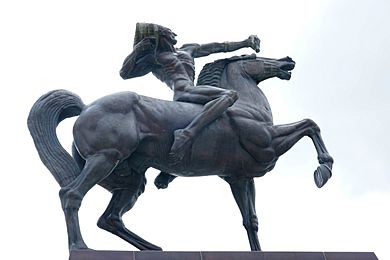The Bowman and The Spearman facts for kids
The Bowman and The Spearman are two amazing bronze statues in Chicago, Illinois. You might also hear them called Equestrian Indians or simply Indians. These sculptures stand like guardians at the entrance to Grant Park, right where Ida B. Wells Drive meets Michigan Avenue.
A famous Croatian artist named Ivan Meštrović created these statues in Zagreb. They were put in place at the park's entrance in 1928. The money for these impressive artworks came from the Benjamin Ferguson Fund.
Contents
About the Statues
Each of these statues is very tall, standing seventeen feet high. They rest on top of a large granite base that is eighteen feet tall. When this area was first planned, the statues were meant to stand guard over a grand staircase leading into the park. However, this staircase was removed in the 1940s when Congress Parkway was made longer.
How the Statues Came to Be
The idea for placing large sculptures at the park entrance came from a famous city planner named Daniel Burnham. In his 1909 Plan of Chicago, Burnham had a big vision for the city's lakefront. He imagined a huge park with beautiful gardens, walking paths, and public art.
Burnham originally thought the two statues should show "one Indian and one 'Buffalo Bill-like' depiction of the conquering white pioneers." This was meant to represent both America's Native American heritage and the country's growth.
The Mystery of the Missing Weapons
One interesting thing about these sculptures is that both figures are missing their weapons. The Bowman doesn't have a bow and arrow, and The Spearman doesn't have a spear. This was actually done on purpose by the artist! Meštrović wanted people to imagine the weapons. He wanted everyone to focus on the strong muscles of the men and horses, and the cool patterns in the horses' manes and tails, as well as the figures' headdresses.
Even though the weapons were never really there, many stories have been told over time about where they supposedly went. Some people thought they were taken as a big joke. Others believed they were removed as a sign of respect after a major event in 2001.
The Artist's Legacy
After creating many statues in Europe and other parts of the world, Ivan Meštrović came back to the United States. He spent the rest of his life as a respected professor. He taught first at Syracuse University and later at the University of Notre Dame.




